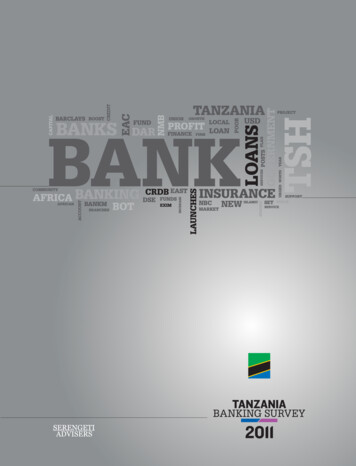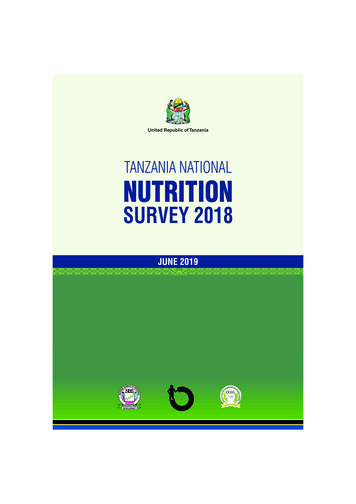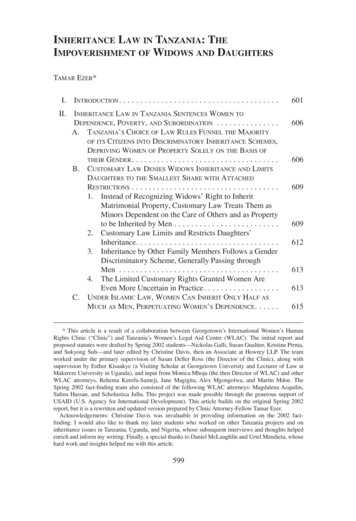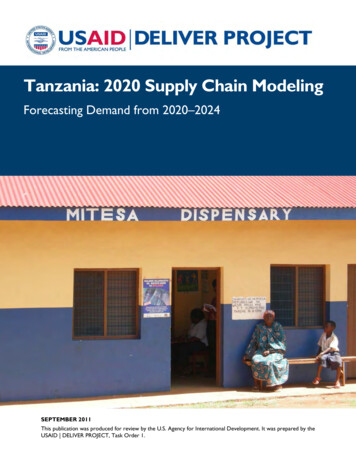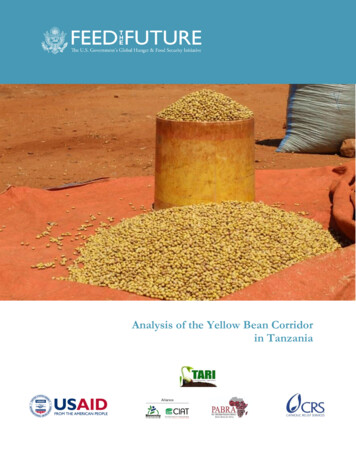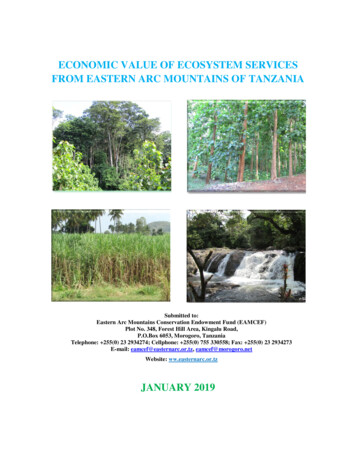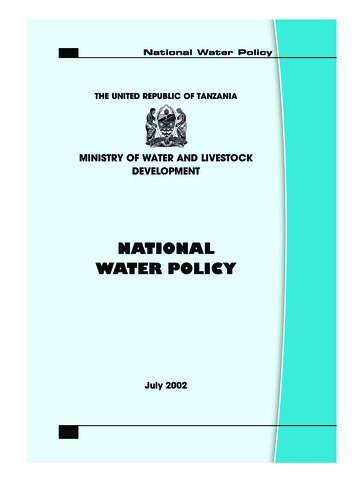
Transcription
National Water PolicyTHE UNITED REPUBLIC OF TANZANIAMINISTRY OF WATER AND LIVESTOCKDEVELOPMENTNATIONALWATER POLICYJuly 2002
National Water PolicyPageii
National Water PolicyCBOsCommunity Based OrganizationsDRADemand Responsive ApproachEIAEnvironmental Impact AssessmentESAsExternal Support AgenciesEWURAEnergy and Water Utilities RegulatoryAuthorityGDPGross Domestic Productl/s/km2litres per second per square kilometrem3/hCubic Meters per HourMISManagement Information SystemNGONon Governmental OrganizationO&MOperation and MaintenancePRSPPoverty Reduction Strategy PaperPSPPrivate Sector ParticipationRWSRural Water SupplyUNUnited NationsUNCEDUnited Nation Conference onEnvironment and DevelopmentUWSAsUrban Water Supply AuthoritiesUWSSUrban Water Supply and SewerageWRMWater Resources ManagementWSSWater Supply and SeweragePageiiiTvÜÉÇçÅá tÇw TuuÜxä tà ÉÇáACRONYMS AND ABBREVIATIONS
National Water PolicyPageiv
National Water PolicyTABLE OF CONTENTSACRONYMS AND ABBREVIATIONS - - - - - - - - - - - - - - - - - - iiiINTRODUCTION - - - - - - - - - - - - - - - - - - - - - - - - - - - - - - - -11.OVERVIEW-------------------------------81.1 Water Resources Potential - - - - - - - - - - - - - - - - - - - - 81.2 Water Resources Depletion - - - - - - - - - - - - - - - - - - 111.3 Present Water Resources Management System - - - 112.WATER AND NATIONALSOCIO-ECONOMIC DEVELOPMENT - - - - - - - - - - - - - 122.1 Domestic Water Supply - - - - - - - - - - - - - - - - - - - - - 122.2 Livestock - - - - - - - - - - - - - - - - - - - - - - - - - - - - - - - - 122.3 Agriculture - - - - - - - - - - - - - - - - - - - - - - - - - - - - - - 132.4 Industry - - - - - - - - - - - - - - - - - - - - - - - - - - - - - - - - - 142.5 Mining - - - - - - - - - - - - - - - - - - - - - - - - - - - - - - - - - - 152.6 Energy - - - - - - - - - - - - - - - - - - - - - - - - - - - - - - - - - 152.7 Fisheries - - - - - - - - - - - - - - - - - - - - - - - - - - - - - - - - -162.8 Environment- - - - - - - - - - - - - - - - - - - - - - - - - - - - 162.9 Wildlife and Tourism - - - - - - - - - - - - - - - - - - - - - - - - 172.10 Forestry and Beekeeping - - - - - - - - - - - - - - - - - - - - 182.11 Navigation - - - - - - - - - - - - - - - - - - - - - - - - - - - - - - 182.12 Transboundary Water Resources - - - - - - - - - - - - - - 183.CHALLENGES IN WATERRESOURCES MANAGEMENT - - - - - - - - - - - - - - - - - - - 193.1 Water Resources Management Challenges - - - - - - 193.2 Rationale for Integrated Water Resources - - - - - - - 203.3 Main Policy Principles in Water ResourcesManagement - - - - - - - - - - - - - - - - - - - - - - - - - - - - 224.POLICY ISSUES IN WATER RESOURCES MANAGEMENT - - 254.1 Water Resources Allocation, Use andSocio Economic Considerations - - - - - - - - - - - - - - - 26PagevgtuÄx Éy VÉÇàxÇàSECTION I:WATER RESOURCES MANAGEMENT - - - - - - - - - - - - - 8
National Water Policy4.2 Water Conservation, WaterQuality Management and Pollution Control - - - - - - 294.3 Water and the Environment - - - - - - - - - - - - - - - - - - 33gtuÄx Éy VÉÇàxÇà4.4 Water Resources Assessment, Planning andDevelopment - - - - - - - - - - - - - - - - - - - - - - - - - - - - 344.5 Data and Information - - - - - - - - - - - - - - - - - - - - - - 374.6 Research and Technological Development - - - - - - 384.7 Training and Human Resources Development - - - - 394.8 Disasters Management - - - - - - - - - - - - - - - - - - - - - 404.9 Trans-boundary Water Resources - - - - - - - - - - - - - - 434.10 Institutional Framework - - - - - - - - - - - - - - - - - - - - - 444.11 Legal and Regulatory Framework forWater Resources Management - - - - - - - - - - - - - - - 484.12 Financing of Water Resources Management - - - - - 49SECTION II:RURAL WATER SUPPLY - - - - - - - - - - - - - - - - - - - - - - 501.OVERVIEW - - - - - - - - - - - - - - - - - - - - - - - - - - - - - - - 502.OBJECTIVES3.PRINCIPLES - - - - - - - - - - - - - - - - - - - - - - - - - - - - - - 524.POLICY ISSUES IN RURAL WATER SUPPLY - - - - - - - - - - 54- - - - - - - - - - - - - - - - - - - - - - - - - - - - - 514.1 Community Participation - - - - - - - - - - - - - - - - - - - - 544.2 Private Sector Participation - - - - - - - - - - - - - - - - - - 574.3 Public Sector Regulation,Facilitation and Co-ordination - - - - - - - - - - - - - - - - 584.4 Domestic Water Supply Minimum Service Level - - - 594.5 Water for Livestock - - - - - - - - - - - - - - - - - - - - - - - - 594.6 Rainwater Harvesting - - - - - - - - - - - - - - - - - - - - - - 604.7 Integration of Water Supply,Sanitation and Hygiene Education - - - - - - - - - - - - 604.8 Gender Sensitivity - - - - - - - - - - - - - - - - - - - - - - - - - 614.9 Service Regulation - - - - - - - - - - - - - - - - - - - - - - - - 624.10 Financing of Rural Water Supply ProgramsPagevi- - - - - - 62
National Water Policy4.11 Legal and Regulatory Framework - - - - - - - - - - - - - 644.12 Institutional Framework - - - - - - - - - - - - - - - - - - - - - 644.13 Co-ordination and Collaboration - - - - - - - - - - - - - 66SECTION III:URBAN WATER SUPPLY AND SEWERAGE - - - - - - - - 671.OVERVIEW - - - - - - - - - - - - - - - - - - - - - - - - - - - - - - - 672.POLICY OBJECTIVES - - - - - - - - - - - - - - - - - - - - - - - - 683.URBAN WATER SUPPLY ANDSEWERAGE PRINCIPLES - - - - - - - - - - - - - - - - - - - - - - 694.THE POLICY IN URBAN WATER SUPPLY AND SEWARAGE - - 704.1 Water Sources and Infrastructures - - - - - - - - - - - - - 704.2 Financing of Urban Water Supplyand Sewerage Services - - - - - - - - - - - - - - - - - - - - - 734.3 Water Demand Management- - - - - - - - - - - - - - - 754.4 Water for Low Income Groups andCommunity User Groups - - - - - - - - - - - - - - - - - - - - 754.5 Waste Water and Environmental Management - - - 774.6 Institutional Framework - - - - - - - - - - - - - - - - - - - - - 784.7 Legal and Regulatory Framework for UWSS - - - - - - 794.8 Private Sector Participation (PSP) - - - - - - - - - - - - - - 804.9 Privatisation of WSS Entities in Small Urban Centres - 814.10 Monitoring and Evaluation - - - - - - - - - - - - - - - - - - 824.11 Accountability to the Public - - - - - - - - - - - - - - - - - 834.12 Capacity Building - - - - - - - - - - - - - - - - - - - - - - - - - 844.13 Research and Technological Development - - - - - - 844.14 Co-ordination and Collaboration - - - - - - - - - - - - - - 85Figure: Map Showing River Basins in TanzaniaPageviigtuÄx Éy VÉÇàxÇà4.14 Monitoring and Evaluation - - - - - - - - - - - - - - - - - - 66
\ÇàÜÉwâvà ÉÇNational Water PolicyPageviii
National Water PolicyINTRODUCTIONFreshwater is a basic natural resource, which sustainslife and provides for various social and economicneeds. In its natural state, water is an integral part ofthe environment whose quantity and quality determinehow it can be used. Safe drinking water and goodsanitation practices are basic considerations forhuman health. Use of contaminated sources posehealth risks to the population as evidenced by theincidences of water borne diseases such as diarrheaand cholera. Despite its importance to our lives anddevelopment, water is unevenly distributed in time,space, quantity and with great variations in quality.Furthermore, water is a finite and a vulnerableresource.The social and economic circumstances prevailingtoday have made particular demands upon thecountry’s water resource base and the environment,and its sustainability is threatened by human inducedactivities. Over the past 15 years these demandshave intensified with the increase in population andconcurrent growth of economic activities requiringwater as an input such as in hydropower generation,irrigated agriculture, industries, tourism, mining, livestockkeeping, domestic, fisheries, wildlife and forestryactivities. Water scarcity is perceived at many placesdue to unreliable rainfall, multiplicity of competinguses, degradation of sources and catchments. Waterscarcity threatens food security, energy productionand environmental integrity and consequently thereare water use conflicts between sectors of theeconomy. There are also increasing challenges ofmanaging the multiple trans-boundary watercoursesPage1\ÇàÜÉwâvà ÉÇ1. Overview
\ÇàÜÉwâvà ÉÇNational Water Policyand strengthening water resources managementpolicy and legal and institutional frameworks.Inadequate regulations to monitor groundwaterresources development has led to underutilization ofthe resources and in some places over exploitationand interference in the existing water sources.Fragmented planning, implemented followingsectoral, regional or district interests, aggravates thissituation even further.Despite significant investment in the Water Supplyservices since the early 1970s, water supply coverageis not satisfactory. The 1991 National Water Policy seta goal of providing clean and safe water to the population within 400 meters from their households by theyear 2002. Today only about 50% of the rural population has access to a reliable water supply service.Due to poor operational and maintenance arrangements, over 30% of the rural water schemes are notfunctioning properly. The coverage for urban areas is73%, but most urban water supplies are inadequatelytreated due to malfunctioning treatment plants.2. RationaleIt is now more than ten years since the 1991 NationalWater Policy was launched. During this period, manychanges have taken place in the sector with majoremphasis on active participation of communities, private sector and local governments as the role ofcentral government in services provision diminishes.For instance, in 1992, one year after launching thepolicy, Tanzania signed Agenda 21, which is an outcome of United Nations Environment Meeting in Riode Janeiro. The Agenda emphasized all nations toprotect natural resources including water resourcesagainst pollution and conservation of the ecosystems.Page2
The main shortfall in the National Water Policy of 1991can be identified in the implementation strategies,which emphasised that the central government is asole investor, implementer and manager of theprojects, both in rural and urban areas. The Policyalso emphasised that the Central Government has aresponsibility of protecting water sources whileenvironmental protection was not accorded its dueimportance.The main objective of this revised policy is to developa comprehensive framework for sustainable development and management of the Nation’s waterresources, in which an effective legal and institutionalframework for its implementation will be put in place.The policy aims at ensuring that beneficiaries participate fully in planning, construction, operation, maintenance and management of community baseddomestic water supply schemes. This policy seeks toaddress cross-sectoral interests in water, watershedmanagement and integrated and participatoryapproaches for water resources planning, development and management. Also, the policy lays a foundation for sustainable development andmanagement of water resources in the changingroles of the Government from service provider to thatof coordination, policy and guidelines formulation,and regulation.Water and The Tanzania 2025 Development VisionThe Tanzania Vision 2025 aims at achieving a highquality livelihood for its people, attain goodgovernance through the rule of law and developa strong and competitive economy.Specific targets include:(i) a high quality livelihood characterized bysustainable and shared growth (equity), andPage3\ÇàÜÉwâvà ÉÇNational Water Policy
National Water Policyfreedom from abject poverty in a democraticenvironment. Specifically the Vision aims at:food self-sufficiency and security,universal primary education and extension oftertiary education,\ÇàÜÉwâvà ÉÇgender equality,universal access to primary health care,75% reduction in infant and maternal mortalityrates,universal access to safe water,increased life expectancy,absence of abject poverty,a well educated and learning society.(ii) good governance and the rule of lawmoral and cultural uprightness,adherence to the rule of law,elimination of corruption.(iii) a strong and competitive economy capable ofproducing sustainable growth and shared benefitsa diversified and semi-industrialized economy,macro-economic stability,a growth rate of 8% per annum,adequate level of physical infrastructure,an active and competitive player in regionaland global markets.Water is one of the most important agents to enableTanzania achieve its Development Vision objectivesPage4
National Water Policy(both social and economic), such as eradicatingpoverty, attaining water and food security, sustainingbiodiversity and sensitive ecosystems. The revisedNational Water Policy and subsequent reviews andreforms of existing laws, institutional framework andstructures are aimed at meeting the objectives of thisVision.Tanzania’s Poverty Reduction Strategy Paper (PRSP)sets out the medium term strategy for poverty reduction and indicators for measuring progress. It definesthe objectives for poverty eradication by 2010, withthe following key priority areas for achieving its goal:(i)reducing poverty through equitable economicgrowth,(ii) improving human capabilities, survival andsocial well being, and(iii) containing extreme vulnerability among thepoor.The PRSP recognises the heavy dependence of thepoor on the environment (soil, water and forests), inparticular household’s reliance on environmentalresources for income generation. Water is considereda key factor in the socio-economic developmentand the fight against poverty. Deliberate efforts aretherefore needed in the management of theresources in order to sustain the desired pattern ofgrowth and consumption, and to ensure that all thesocio-economic activities maximize their capacities,as articulated in the Vision 2025. This entails integrated planning, development and river basin management in support of food security and poverty reduction as well as environmental safeguards.Page5\ÇàÜÉwâvà ÉÇWater and Poverty Alleviation
National Water Policy\ÇàÜÉwâvà ÉÇ3. The ProcessThe process of preparing this policy was undertakenin a participatory manner involving water resourcesstakeholders in order to ensure comprehensivenessand acceptability. A number of technical studieswere undertaken to provide input to the policyreview process. Many key stakeholders wereinvolved at different levels in different forumsincluding field consultations, meetings, technicalworkshops and national conferences. The draftNational Water Policy was subjected to review bywater sector related ministries, universities, researchinstitutions and non-governmental organizations.4. The StructureThis policy document contains three sectionsaddressing three sub-sector issues namely:(i)Water Resources Management,(ii) Rural Water Supply, and(iii) Urban Water Supply and Sewerage.The Water Resources Management section providesa comprehensive framework for promoting optimal,sustainable and equitable development and use ofwater resources for the benefit of the present and thefuture generations. It takes into consideration theconcerns of all water users. The Rural Water Supplysection aims at improving health and alleviatingpoverty of the rural population through improvedaccess to adequate and safe water. The UrbanWater Supply and Sewerage section sets aframework for achieving an efficient developmentand management of the Urban Water Supply andSewerage services. A plan for action detailing theimplementation of policyPage6
National Water Policystrategies will be prepared and presented separately.5. Instruments for Policy Implementation(i)Technical instruments: These are technicalmeasures, which are used to control water usesincluding gating of abstractions, flow metering,application of cleaner production technology.(ii) Economic instruments: Economic instrumentsinclude water pricing, charges, penalties andincentives to be used to stimulate marketingmechanism, and serve as an incentive toconserve water, and reduce pollution of watersources. This instrument will also facilitate waterallocations.(iii) Administrative instruments: Administrativeinstruments include information management systems and monitoring, information products, waterresources plans including water source protectionplans, water resources models and decision support systems, various water resources guidelines.(iv) Legal instruments: Legal instruments includerestrictions and all prohibitions imposed by theregulatory body and the Government. These areindividual licenses for abstractions and their revisions, guidelines, discharge permits, codes ofconduct, guidelines, standards, EnvironmentImpact Assessments, and agreements, treatiesand protocols for trans-boundary waterresources.(v) Regulatory instruments: Regulatory instrumentsinclude appropriate management structuresPage7\ÇàÜÉwâvà ÉÇSix types of instruments and other measures tobe instituted from time to time will be used in theimplementation of the policy:
jtàxÜ exáÉâÜvxá tÇtzxÅxÇàNational Water Policyand procedures. These procedures and criteriato be adopted include applications for andgranting of permits, a clearly defined waterright system, appropriate standards and guidelines that control water abstractions from waterbodies, controls on specific technologiesaimed at reducing water use or waste loads,control of discharge of waste products intowater sources (in terms of quantity, quality, timing and location of discharges), and standardsfor water provided for specific uses or for goodsor materials which are potentially polluting.(vi) Participatory Instruments: These include sensitization, community education, consultationsand discussions.SECTION I:WATER RESOURCES MANAGEMENT1. OVERVIEW1.1 Water Resources PotentialAlthough nearly 70% of the Earth is covered withwater, only 2.5% of this is freshwater. Seventy percentof the freshwater is frozen in ice caps of Antarctica,Arctic and Greenland. The remaining 30% of thisfreshwater is available as soil moisture, or lies in deepunderground aquifers as groundwater and as surfacewater. Only one third of this water is the water foundin lakes, rivers, reservoirs and those undergroundwater sources that are shallow enough to be tappedat an affordable cost. Only this amount is regularlyrenewed by rain and snowfall, and therefore available on a sustainable basis. When the world's totalPage8
river flow (42,700 cubic kilometers) is divided by theworld population (of 1995) estimated to be 5.85 billion,the quotient amounts to an average of 7,300 cubicmeters of water per person per year (ComprehensiveAssessment of The Freshwater Resources of The WorldReport, UN 1997). Owing to the growing world population, this represents a drop of 37 per cent per personsince 1970.Tanzania’s annual renewable water resources is 89cubic kilometers or 2,700 cubic meters of water perperson per year (World Resources 2000- 2001). Basedon projected population from estimated 33 million inyear 2001 to about 59.8 million by year 2025, annualaverage available water per capita will be reducedby 45% to about 1,500 cubic meters per person peryear which shows that the country will face a waterstress situation, considering that below 1,700 cubicmeters per person per year signifies water scarcity.Water resources in the country include rivers, lakes,wetlands, springs, reservoirs and groundwater aquifers;and many water bodies that are shared with neighbouring countries. More than half of the countryreceives on the average less than 800mm of rain peryear. The monsoon type of climate prevailing in thecountry, cause extreme temporal variability in rainfalland even more extreme variability in river flows. Theannual mean rainfall shows that the eastern coastalareas receive well over 1000mm per year while mostparts of the drier interior receive less than 600mm.Other areas with relatively high annual rainfall are nearthe great lakes, notably Lake Victoria and north ofLake Nyasa. The surface runoff pattern and moistureconditions correspond to the general rainfall pattern.On the southwestern highlands, Uluguru, Ukaguru andUsambara mountain ranges, the slopes of MountPage9jtàxÜ exáÉâÜvxá tÇtzxÅxÇàNational Water Policy
jtàxÜ exáÉâÜvxá tÇtzxÅxÇàNational Water PolicyKilimanjaro and Meru, as well as the most western partsof the country, where annual rainfall is in the range of1,200-2,600mm, streams and rivers are perennial. In manyother parts of the country, with less than 800 mm of rainper annum and which is highly variable, streams flowintermittently.Freshwater is also abundant in the form of lakes coveringapproximately 60,000 square kilometers. LakeTanganyika shared by Tanzania, the DemocraticRepublic of the Congo, Burundi and Zambia runs alongthe western border and this is Africa's deepest andlongest freshwater lake, and the world's second deepestlake. Lake Victoria shared by Tanzania, Kenya andUganda is the world's second largest freshwater lakeand drains into the Nile river. Lake Nyasa in the south ofthe country is shared by Malawi, Tanzania andMozambique; and is situated in the Zambezi River system(Basin).Groundwater availability, mainly controlled by geologyand climate, is variable. Aquifers are discrete. About 75%of the country is underlain by Precambrian Basementcomplex, which comprises of hard, consolidated andsometimes metamorphosed rocks. These rocks formbasement aquifers, where they are weathered, fractured or faulted. Other types are Karroo and youngeraquifers, coastal sedimentary formation of limestoneand sandstone, and the alluvial sedimentary sequence,which mostly include clay, silt, sand and gravel, and volcanic materials found in alluvial plains. Volcanic areas ofnorthern and southern Tanzania as well as the sedimentary coastal basins are potential groundwater resourceareas. Boreholes drilled in the volcanic areas have yieldsup to 800 cubic meters per hour and those in sedimentary coastal areas yield about 50 cubic meters per hour.However, water quality is a problem in terms of highPage10
salinity and fluoride concentration, and thus not suitablefor human use. Groundwater is a major supplement forsurface water for many parts of the country and is a vitalsource of water in semi-arid water scarce areas.1.2 Water Resources DepletionWater resources depletion and rising demand on limitedwater supplies result in putting at risk some of the waterrelated investments, thereby creating conflicts. Extensiveirrigation during dry season dries up the rivers, thus disturbing ecosystems and wildlife. Inefficient water uses,such as low efficiencies of many irrigation schemes, (estimated at 10% to 15%); and leakages from domesticwater supplies estimated to cause water losses up to52% of water that is produced; both of which contributeto reduction in water availability.1.3 Present Water Resources Management SystemThe Water Utilization (Control and Regulation) Act No. 42 of1974 and its subsequent amendments govern the presentwater resources management system. Amendment ActNo. 10 of 1981 introduced pollution control aspects.However, the Water Utilization Act and other sub-sectorwater related laws are inadequate to meet the growingwater resources management challenges facing thecountry today.The country is divided into nine hydrological zones or riverbasins (Figure: River Basins in Tanzania) for purposes ofwater resources management. These basins are (i)Pangani, (ii) Wami/Ruvu, (iii) Rufiji, (iv) Ruvuma andSouthern Coast, all of which drain into the Indian Ocean,and (v) Lake Nyasa, (vi) Lake Rukwa, (vii) Lake Tanganyika,(viii) Lake Victoria, and (ix) the Internal drainage basins ofLake Eyasi, Manyara and Bubu depression.Page11jtàxÜ exáÉâÜvxá tÇtzxÅxÇàNational Water Policy
jtàxÜ exáÉâÜvxá tÇtzxÅxÇàNational Water PolicyBasin water resources are part of a management continuum starting with the upstream freshwater sources inthe watershed, moving down into the freshwater-seawater interface in the deltas and estuaries.2. WATER AND SOCIAL - ECONOMIC DEVELOPMENTWater is a basic natural resource for socio - economicdevelopment. It is fundamental for various social –economic development activities such as industrialproduction, irrigated agriculture, livestock keeping,mineral processing, hydropower production, navigation and recreation and tourism.2.1 Domestic Water SupplyThe present population is estimated at about 34million, of which 80% live in the rural areas. Theprojected population in the year 2025 is estimated todouble, with 60% living in the rural areas. The growthin population will have a negative impact on domestic water supply and in sanitation and sewerage services if appropriate measures are not taken. Presentlywater services coverage for municipal and industrialwater supply is 73% and for rural water supply it is 50%.This coverage in the provision of safe water is undesirably low. In many areas of the dry central part of thecountry water is so scarce that even water for personal hygiene cannot easily be found. The people,especially women and children, walk long distancesto fetch water. The national economy suffersbecause of inadequate water supplies to the urbanand rural population.2.2 LivestockIn the year 2000 livestock contributed about 13.3 percent of the Agricultural Gross Domestic ProductPage12
ment and management. Also, the policy lays a foun-dation for sustainable development and management of water resources in the changing roles of the Government from service provider to that of coordination, policy and guidelines formulation, and regulation. Water and The Tanzania 2025 Development Vision The Tanzania Vision 2025 aims at achieving .
